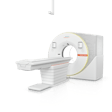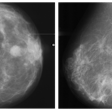CHICAGO -- Breast masses detected by ultrasound in pediatric patients can be treated by pediatric specialists and not adult centers, suggest findings presented December 3 at RSNA 2024.
In her presentation, Valeria Peña-Trujillo, MD, from Massachusetts General Hospital in Boston, discussed her team’s findings, showing that breast masses in this patient population are benign and most commonly present as fibroadenoma.
 Valeria Peña-Trujillo, MD, from Massachusetts General Hospital presents research results showing that breast masses in pediatric patients are generally benign and can be managed by pediatric specialists rather than adult breast centers.
Valeria Peña-Trujillo, MD, from Massachusetts General Hospital presents research results showing that breast masses in pediatric patients are generally benign and can be managed by pediatric specialists rather than adult breast centers.
“Our data suggests that most cases can be managed with observation or conservative approaches, avoiding the risks associated with invasive procedures,” Trujillo told AuntMinnie.com.
The rate of children developing breast masses is low. Fibroadenoma, cysts, and fibrocystic changes make up most pediatric breast masses. However, when these masses do present themselves, they can cause stress and anxiety for patients and their families.
Trujillo said that smaller pediatric departments within larger adult hospital systems often direct child patients with breast concerns to dedicated breast centers. These are designed for adult care, which may not always provide the most suitable environment for young patients, she added. For example, children may associate adult hospitals with serious illness, adding to their anxiety. Additionally, the maturity gap and lack of age-appropriate communication may also feel threatening to children.
The researchers evaluated the prevalence and outcome of breast masses with ultrasound evaluation and biopsy in child patients.
The study included data collected between 2018 and 2024 from 779 breast ultrasound exams of children ages 13 to 18. The team excluded patients who underwent aspiration of a breast fluid collection.
Of the total exams, 78 (10%) required ultrasound-guided breast mass biopsies. And of these biopsy cases, 29 (37%) underwent surgical excision. From the total biopsies, the researchers found the following: 48 fibroadenoma cases, 15 benign fibroepithelial lesions, seven normal breast tissue cases, and eight cases labeled as “other” (nodular fasciitis, benign phyllodes, nodular adenosis, and papilloma). They found no malignancies in the total cases.
Trujillo said that with these results in mind, adolescent breast masses should be managed within pediatric centers rather than adult breast centers. She highlighted that pediatric radiologists are highly trained specialists who are dedicated to treating children, that such facilities are specifically designed for children to reduce anxiety, and that pediatric radiologists have a deep understanding of pediatric conditions for improved care strategies that may not require invasive procedures like surgery.
“Pediatric facilities are designed to reduce anxiety in young patients, with child-friendly environments and communication tailored to children in the developmental stages, so it will be a more amenable stage for all pediatric patients,” she told AuntMinnie.com.
To view full coverage of RSNA 2024, visit our RADCast.



















